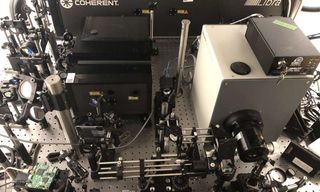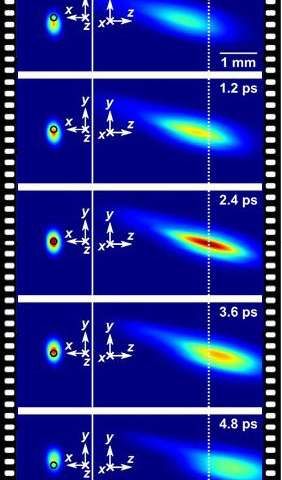The New Fastest Camera in the World Sees Lasers Move at 10 Trillion Frames Per Second

What do you do when you have an experiment that's over too fast for even the fastest cameras in the world to see?
For a trio of researchers at the California Institute of Technology, the answer was simple: Build a faster camera.
Previously, the fastest video cameras in the world had framerates of one-one-hundred-billionth of a second. That was fast — A hundred-billionth of a second is just enough time for a beam of light to travel the length of a sesame seed. But it wasn't fast enough.
Researchers working with advanced lasers had developed a technique called "temporal focusing" where a laser pulse could be made to fire over incredibly short, compressed periods of time. The whole beam of light would rush out all at once, and researchers knew that temporally focused lasers behaved differently from lasers emitted over longer periods of time. [10 Real-Life Superhero Technologies]
But the existing cameras were just too slow to study them. There were some ways to get around this problem in other ultra-fast exeriments. Researchers would sometimes run the same experiment over and over in front of the same, too-slow camera until it had collected enough different frames of action to string together into a single, complete movie. This wouldn't work for crashing a compressed laser into a surface like etched glass though; the researchers wanted to see what that looked like, but they knew it would look different each time. There was no way to string multiple experiments together into a single movie.

So the three scientists came up with a technology they call single-shot 10-trillion-frame-per-second compressed ultrafast photography (T-CUP). One hundred times faster than the previous fastest recording method, T-CUP works by combining movie data with data from a still image. As the researchers described in a paper published Aug. 8 in the journal Nature, T-CUP splits the image of the laser into two devices: a motion recorder and a camera that makes a single exposure of the scene. The movie camera captures the scene at the screaming edge of what's possible for it to see. The still camera makes a single, smeared shot of the laser's whole motion.
Then, a computer combines the data from the two cameras, using the smeared image from the still camera to fill in the gaps in the movie. The result? A 450-by-150 pixel video that lasts for 350 frames.
Sign up for the Live Science daily newsletter now
Get the world’s most fascinating discoveries delivered straight to your inbox.
Originally published on Live Science.

